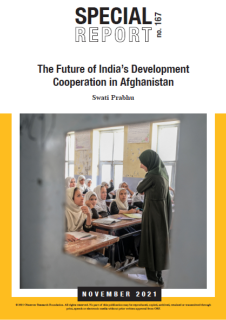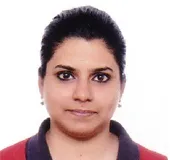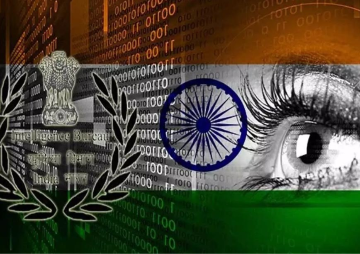Introduction
Afghanistan has been suffering wars and civil strife for decades, and remains one of the poorest countries in the world. Today at least 18 million people, or about half of the country’s population, are on the brink of severe food insecurity.[1] Since the invasion of United States-led forces in 2001, the international community has made immense efforts to rebuild Afghanistan. Significant resources have been spent on military support, infrastructure development, and reviving the economy. Till date, the World Bank has committed more than USD 5.3 billion for development projects in Afghanistan[2] and the Asian Development Bank has pledged almost USD 5.39 million in grants and provided USD 120.4 million in technical assistance to Afghanistan since 1966.
India has been one of the biggest contributors towards global efforts at reconstructing Afghanistan. Indeed, the country is the largest regional donor in Afghanistan and has contributed nearly USD 3 billion for infrastructure and institutional development. It helped build the Indira Gandhi Institute of Child Health (IGICH), and is engaged in the School Feeding Programme.[3] According to data from 2017, some 15,000 Afghan students study in India and 3,500 Afghan officials are trained in the country every year. New Delhi also offers over 600 Indian Technical and Economic Cooperation (ITEC) slots to Afghan citizens every year. These efforts from India, along with assistance from other countries, have helped Afghanistan achieve some degree of progress in certain areas such as gender equality, health, and incomes. Child mortality rate, for instance, declined from 90.2 per 1,000 livebirths in 2000 to 46.5 per 1,000 livebirths in 2019.[4] To be sure, however, Afghanistan continues to face massive challenges, and is ranked ninth on the 2020 Fund for Peace’s Fragile State Index.
The Taliban’s return threatens to undermine the changes that have occurred in Afghanistan in the past two decades. Furthermore, Afghanistan stands in the firing line of sanctions from the international community, including from the World Bank, the International Monetary Fund (IMF), and various European nations.
On 28 September 2021, ORF’s Centre for New Economic Diplomacy (CNED) organised a virtual roundtable with a diverse panel of diplomats, academics, and members of civil society. The roundtable, which was held under the Chatham House Rule, aimed to address the following issues:
- What should be the framework of India’s development cooperation in Afghanistan?
- Should aid be linked to the behaviour of the Taliban regime?
- How should the international community ensure accountability of aid in Afghanistan?
Development Cooperation with Afghanistan, Post-2001
Over the last two decades, India’s development partnership with Afghanistan has had four fundamental elements: a) humanitarian assistance; b) infrastructural projects; c) small and community-based development projects; and d) capacity-building programmes.
As part of India’s food aid initiatives under the humanitarian assistance programmes, it has channelled donations of wheat amounting to one million tonnes for the manufacture of biscuits for distribution in Afghan schools. Launched as the ‘School Feeding Programme’ in 2002, the initiative is being undertaken with the help of the UN’s World Food Programme (WFP). However, Pakistan has been making it difficult for India to transit through its territory. (The most cost-effective route to Kabul is through Islamabad.)
Indeed, the complexities of India and Pakistan’s security relations resulted in New Delhi paying more as transportation costs to the UN. This also reflects the failure of the UN and other international partners (such as the US) in reaching a solution involving the Pakistani agencies. It has compelled New Delhi to ship donations using WFP’s vehicles through the extended route of Chabahar port in Iran.
New Delhi has also been engaged with mobilising medical aid in the form of Indian Medical Missions (IMM), initially established in the cities of Kabul, Herat, Jalalabad, Kandahar and Mazar-e-Sharif. One of the highlights of its medical services to Afghanistan has been the Indira Gandhi Institute of Child Health (IGICH)— the first paediatric hospital in the country. India has also aided in the reconstruction of roadways and highways as part of its infrastructural projects to enhance connectivity in the region, in particular to promote trade ties and transit tracks with neighbouring countries such as Iran. India has also provided assistance in establishing high-voltage transmission lines for electricity generation to help fill the gap in energy supply. India has initiated other projects in the energy sector as well, including the Salma Dam project, the Pul-e-Khumri to Kabul Transmission Line, and the Chimtala Sub-station.
Under the small and community-based development projects, the local Afghan district-level governments or the NGOs were encouraged to administer a scheme or a task, thereby fostering the value of ownership, accountability, and partnership. India provided financing and encouraged projects at the grassroots level: primary healthcare centres, small bridges or culverts to provide connectivity to remote villages, and vocational training centres.
Capacity-building, as the fourth element of India’s assistance programme, relates to the ITEC programme. Some 625 slots have been given to Afghan professionals, civilians and diplomats as of 2019.[5]
Development Cooperation Under Taliban 2.0
The return of the Taliban in 2021 casts a shadow on the ongoing as well as future projects committed by India’s development cooperation and other international partners. In July, India closed its consulate in Kandahar and a month later, its Mazar-e-Sharif consulate and embassy in Kabul, too.[6]
If India is to provide assistance to Afghanistan, the only form would likely be humanitarian aid. To do this, however, a “humanitarian aid corridor” should be created, given how Pakistan does not permit a free two-way transit between India and Afghanistan. Such an aid corridor is conceivable either by involving the United Arab Emirates (UAE) authorities via Dubai or through Islamabad; it would be possible only through serious intervention from international agencies, primarily the UN.
Yet even with an aid corridor via Dubai, India might still find it difficult to transport high-volume commodities such as wheat or rice. India is considering options for transporting about 50,000 metric tonnes of wheat to Afghanistan, along with medical aid.[7] However, as remarked by India’s External Affairs Minister S. Jaishankar at the UN Summit in September, India’s willingness to send humanitarian assistance relies heavily on whether the UN can create an “enabling environment”.[8] Prime Minister Narendra Modi too, reiterated this in his G20 address in early October, when he highlighted the importance of “unhindered and urgent humanitarian assistance for the Afghans.”[9] At the recently held G20 Summit in Rome, India issued a call for collective global action in response to the Afghan crisis.
India can work together with other countries, such as the European Union (EU) or the United Kingdom (UK) to coordinate an international response to engage more effectively with the Taliban regime.
India’s Humanitarian Assistance and Afghanistan’s Political Realities
The idea of providing humanitarian assistance through an “aid corridor” has to consider the nature of the Taliban. At ORF-CNED’s roundtable, participants agreed that the group is not a rational entity. They underlined their view that the Taliban do not intend to govern, but rather, to rule, and rule through military means. They are an extremely sophisticated group with clear objectives of exploiting the current humanitarian crisis to obtain support from outside and legitimise their existence in the long-run. Key to its strategies is creating a fear psychosis among its population. It is imperative, therefore, that whatever aid India manages to channel to Afghanistan, say through the humanitarian aid corridor, actually benefits the Afghan people.
Furthermore, the humanitarian crisis in Afghanistan should not be viewed in silos as it is the outcome of the political realities that have unfolded in the region over the past few decades. The international community has failed to exert concerted efforts towards comprehending the situation in its entirety.
Part of this understanding should involve acknowledging that while the Taliban may appear to be consolidating, it is in fact deteriorating. Over the past two decades, the development initiatives that have been undertaken by India and other countries have succeeded in showing the Afghan people what a government is supposed to do for its citizens. Today the Afghans are aware that change is indeed possible: technological progress, women’s empowerment, infrastructural growth, and education. The Taliban regime will be hard-pressed to fulfil these goals.
ORF-CNED’s discussion also delved into how the Taliban, as a monolithic entity, is learning the “art of negotiation” and maintaining cordial relations with terrorist outfits such as Lashkar-e-Taiba (LeT), the Arab Jihadists, and certain elements of ISIS; it also has organic ties with the Pakistani establishment. Amidst all this, the Taliban are pushing hard to further their interests—if they give in to the demands of the international community, they could lose control and, eventually, their own fighters as well. In this context, addressing solely the humanitarian crisis may not yield positive results and would again result in a massive waste of resources, efforts, and finances.
The Role of Civil Society
The outcome of development cooperation initiatives is closely related to the choice of partners. In the case of Afghanistan, there are two options involved: one pertains to those in government, and the second is civil society. It is uncertain whether communicating the shared developed ambitions with the Taliban regime is possible at all, and if the Taliban in fact concerns itself with the developmental needs of the Afghan people.
The question therefore is how to ensure the accountability of aid. This could be possibly countered with a need-convergence-urgency-shelf life model based argument. It is a known fact that there is a need or a demand for aid, which opens opportunities for India to offer assistance. However, development aid under this new regime is guided by the Sharia law, which has no commonly accepted interpretation. Under such an ambiguous scenario, it is difficult to find a convergence of interests and ambitions. The level of the international community’s engagement with the Taliban is contingent upon the graduated response of the regime—i.e., if the regime actually intends to work for the welfare of the people, then aid can be accounted for. Here, the role of civil society, both those inside Afghanistan and outside, is crucial.
Post-9/11, there was a rise in certain sets of civil society elites based in Kabul who operated along certain assumptions. They were either divorced from the political realities facing the ordinary Afghans, or else were toeing the line with the donors without sufficient understanding of the reality at the grassroots. In all these years, the edifice of the international community’s understanding of who the “Afghan people” are, has stood on these assumptions of the elites. Therefore, for India, it is essential to forge partnerships with the non-elites or the ‘ordinary’ Afghan people who appreciate the value of development because they need it the most. These Afghans could become more reliable partners for India and other countries, who would look beyond the prism of political or short-term gains.
It is important to make the partnership credible for both India and Afghanistan, i.e., engaging with the private Afghan citizens on one hand, and on the other, providing them continued, reliable and assured support. However, the future of this engagement would be seriously jeopardised if the current Taliban regime turns rogue in the future—a scenario that is not unlikely. Given the geoeconomic realities churning in the region, India certainly has an edge over other actors with its history of participation in a variety of sectors for years. Moreover, India must remember that an assessment of the ground realities is an important constituent of the development partnership to keep a check on Taliban mindsets.
Female Education in Afghanistan: The Role of Indian EdTech
While the subject of girls’ education was not discussed during ORF-CNED’s roundtable, it is an important consideration too, when pondering the future of India’s cooperation with Afghanistan. During their earlier rule, the Taliban banned women from public life and gave them no access to education and other social rights. So far, it does not appear that the Taliban’s return will be anything different. At the time of writing this report, the interim government has been announced, without any representation of women.[10] The Taliban have also announced the reopening of high schools, and only for boys.[11] There is anecdotal evidence that Afghan women who have jobs are afraid of the consequences of their breaking Taliban-imposed taboos.[12]
In such a scenario, online education could potentially help girls access some form of education. As societies turned to online education because of the Covid-19 pandemic, the edtech sector has advanced in India;[13] this can help Afghanistan’s girls. These online education platforms can assist school children as well as working professionals for learning, upgrading their skills, and undertaking tech training. As a regional ally of Afghanistan and a pivotal actor in the region, India can play a huge role in supporting the Afghan education sector through edtech services.[14]
Conclusion
The situation in Afghanistan, more than two months after the fall of Kabul to the Taliban, remains uncertain. The international response to the crisis in Afghanistan should prioritise development cooperation.
India needs to ponder its engagement with Afghanistan, with full consideration of the emerging political and geoeconomic realities in the region. As New Delhi’s presence in Afghanistan is in a state of flux, it must utilise the multilateral channel and work to establish a humanitarian aid corridor in order to disburse humanitarian support to the Afghan people. It is essential to ensure the accountability of aid by including civil society, especially at the grassroots, in the process.
Endnotes
[1] “World must Act on ‘make or break moment’- UN Chief”, UN News, Afghanistan, October 11, 2021.
[2] The World Bank in Afghanistan.
[3] Ministry of External Affairs, India-Afghanistan: A Development Partnership.
[4] World Bank, Mortality Rate, Infant (per 1,000 live births)- Afghanistan.
[5] Embassy of India to Kabul, Afghanistan, ‘ITEC Fellowships’.
[6] Nayanima Basu, “India Unlikely to Reopen Kabul Embassy in Near Future, Only People-to-People links to Continue”, The Print, September 6, 2021.
[7] Sachin Parashar, “Afghanistan in Food Crisis, India Plans to Send 50,000MT of Wheat”, The Times of India, October 19, 2021.
[8] Parashar, “Afghanistan in Food Crisis, India Plans to Send 50,000MT of Wheat”
[9] “G20: PM Expected to Call for United Approach to Deal with Afghan Crisis”, Business Standard, October 24, 2021.
[10] Shabhnam von Hein, “Afghanistan: Girls’ Education Faces Bleak Future under Taliban Rule”, Deutsche Welle (DW), September 23, 2021.
[11] Emma Graham-Harrison, “Taliban Ban Girls from Secondary Education in Afghanistan”, The Guardian, September 17, 2021.
[12] Kate Duffy, “The Founder of a Kabul-based Startup Says She Deleted Details of her Female Staff to Protect Them as the Taliban Neared the City”, Business Insider India, August 23, 2021.
[13] Ninad D Sheth, “India’s EdTech Startups Use Lockdown as Springboards for Growth”, Nikkei Asia, August 5, 2020.
[14] “India’s Role as Regional Ally Can Help in Afghanistan: US Official”, Business Standard, September 11, 2021.
The views expressed above belong to the author(s). ORF research and analyses now available on Telegram! Click here to access our curated content — blogs, longforms and interviews.

 PDF Download
PDF Download



 PREV
PREV


